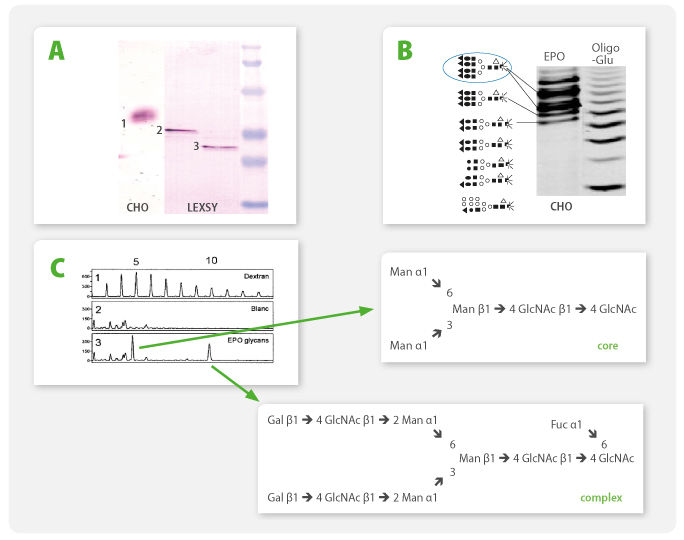Glycosylation is a major posttranslational modification of a large variety of secreted and membrane proteins and is often a pivotal factor for folding, function and stability. Due to the absence of glycosylation pathways in prokaryotes, recombinant glycosylated proteins cannot be produced in e.g. bacteria. Further, glycosylation in most alternative eukaryotic expression hosts such as yeast and insect differs largely from the desired mammalian-type glycosylation. Despite several improvements including glycoengineering have been reported for these two systems, an expression system with adequate mammalian-type glycosylation is still highly desirable for protein expression in research, diagnostics and pharmaceutical applications.
Glycosylation in LEXSY was thoroughly investigated using recombinant human erythropoietin (EPO) as a model. EPO expressed in LEXSY was shown to be efficiently secreted into the culture medium, natively processed at the N-terminus and fully biologically active. Glycosylation analysis revealed two glycans, a complex mammalian-type biantennary oligosaccharide and the Man3GlcNAc2 core structure (Breitling et al. 2002). LEXSY is thus the first biotechnologically useful unicellular eukaryotic system producing biantennary fully galactosylated, core α-1,6-fucosylated N-glycans. In addition, the N-glycosylation pattern was exceptionally homogenous consisting of only two defined glycoforms. This glycosylation pattern was also found in LEXSY expressed human interferon γ; and host gp63 surface glycoprotein. While glycoproteins from other eukaryotes are typically heterogenous multi-glycoform populations, LEXSY-derived proteins are expected to be prone to crystallization and subsequent structure determination.

Analysis of recombinant human Erythropoietin (EPO) isolated from culture supernatants of a LEXSY expression strain. A: Western blot of commercial recombinant human EPO produced in CHO cells (1) and LEXSY secreted EPO before (2) and following (3) de-glycosylation with N-glycosidase F (PNG). B: Electrophoretic resolution of heterogenous population of CHO-derived EPO. Glycan structures are depicted at left. C: Enzymatic resolution of complex and core glycan structures released from LEXSY-produced EPO (for details refer to Breitling et al. 2002).